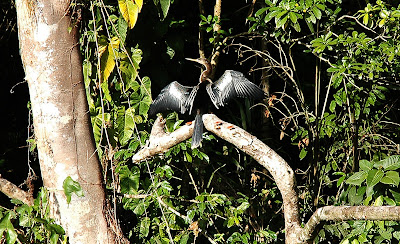
On a trip to
Let me quote you the description of this scene in my book The Cockroach Catcher:
Its ability to swallow fairly good size fish has been observed and with fish stock not always available, it has the uncanny ability of swallowing a fairly high number of fishes. However, they seem to prefer to kill the fish first. A struggling fish in the stomach may not indeed be the most pleasant thing even for the Anhinga.
There seems little the poor fish can do when faced with such advanced credential in the evolutionary war. That the Anhinga has survived without much evolving is a clear endorsement of its hunting skills. I wonder if its stripy wings mimic shoals of fish under water thus giving the real fish a false sense of comradeship.
In
The fish looked truly dead. In normal circumstances, one flick was enough. It had two. Or was it three?
The bird was now relaxed. Why rush when you can wait till the previous fish is fully down? Spread your wings a bit – there is a huge audience of tourists. It was a beautiful sight – a female Anhinga spreading out its wings. It was indeed a sculpture of exceptional beauty. More cameras clicked and more video whined.
Suddenly. Very suddenly. The little fish came to life. Made a couple of strong wriggly movements, slid into the water and swam off. By the time the Anhinga realised, it was a split second too late. The fish disappeared into the mangrove roots.
We all spontaneously clapped. Support the “under-dog”. Or should it be “under-fish”?
The oldest defence: faking. Not just faking, but faking death.”
Richard Dawkins wrote in his famous book Selfish Gene:
As an illustration, he observed:
In my child psychiatric practice, I came across a number of children who seemed to have made good use of faking. (In The Cockroach Catcher, there are stories of a limping boy, a boy with non-stoppable hiccup, and a 12-year girl who suddenly thought she was only 3 ½.) I have now come to realise that the human brain is often well equipped to protect its owner and wonder about the role of our intervention.

2 comments:
This is so interesting. I wish there were shots of the 7 inch fish faking death. Thanks for sharing. am am
Well, it was indeed difficult and partly I do not want to put up a less than perfect pic. the story was unbelievably real. In nature as in human existence we have to make use of all defence mechanisms. I tried to extrapolate what I observed in nature to our daily struggle.
Post a Comment